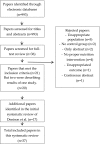Nutrition and physical activity in the prevention and treatment of sarcopenia: systematic review
- PMID: 28251287
- PMCID: PMC5457808
- DOI: 10.1007/s00198-017-3980-9
Nutrition and physical activity in the prevention and treatment of sarcopenia: systematic review
Abstract
This systematic review summarizes the effect of combined exercise and nutrition intervention on muscle mass and muscle function. A total of 37 RCTs were identified. Results indicate that physical exercise has a positive impact on muscle mass and muscle function in subjects aged 65 years and older. However, any interactive effect of dietary supplementation appears to be limited.
Introduction: In 2013, Denison et al. conducted a systematic review including 17 randomized controlled trials (RCTs) to explore the effect of combined exercise and nutrition intervention to improve muscle mass, muscle strength, or physical performance in older people. They concluded that further studies were needed to provide evidence upon which public health and clinical recommendations could be based. The purpose of the present work was to update the prior systematic review and include studies published up to October 2015.
Methods: Using the electronic databases MEDLINE and EMBASE, we identified RCTs which assessed the combined effect of exercise training and nutritional supplementation on muscle strength, muscle mass, or physical performance in subjects aged 60 years and over. Study selection and data extraction were performed by two independent reviewers.
Results: The search strategy identified 21 additional RCTs giving a total of 37 RCTs. Studies were heterogeneous in terms of protocols for physical exercise and dietary supplementation (proteins, essential amino acids, creatine, β-hydroxy-β-methylbuthyrate, vitamin D, multi-nutrients, or other). In 79% of the studies (27/34 RCTs), muscle mass increased with exercise but an additional effect of nutrition was only found in 8 RCTs (23.5%). Muscle strength increased in 82.8% of the studies (29/35 RCTs) following exercise intervention, and dietary supplementation showed additional benefits in only a small number of studies (8/35 RCTS, 22.8%). Finally, the majority of studies showed an increase of physical performance following exercise intervention (26/28 RCTs, 92.8%) but interaction with nutrition supplementation was only found in 14.3% of these studies (4/28 RCTs).
Conclusion: Physical exercise has a positive impact on muscle mass and muscle function in healthy subjects aged 60 years and older. The biggest effect of exercise intervention, of any type, has been seen on physical performance (gait speed, chair rising test, balance, SPPB test, etc.). We observed huge variations in regard to the dietary supplementation protocols. Based on the included studies, mainly performed on well-nourished subjects, the interactive effect of dietary supplementation on muscle function appears limited.
Keywords: Dietary; Intervention; Physical activity; Sarcopenia.
Conflict of interest statement
N Binkley received research support from Amgen, GE Healthcare, and Lilly, Merck and consultant/advisory board fees from Amgen, Astellas, Lilly, Merck, Nestle, and Radius. J-Y Reginster received consulting fees or paid advisory boards from Servier, Novartis, Negma, Lilly, Wyeth, Amgen, GlaxoSmithKline, Roche, Merckle, Nycomed-Takeda, NPS, IBSA-Genevrier, Theramex, UCB, Asahi Kasei, Endocyte, and Radius Health; lecture fees from Merck Sharp and Dohme, Lilly, Rottapharm, IBSA, Genevrier, Novartis, Servier, Roche, GlaxoSmithKline, Merckle, Teijin, Teva, Analis, Theramex, Nycomed, NovoNordisk, Ebewee Pharma, Zodiac, Danone, Will Pharma, Amgen, and PharmEvo; and grant support from Bristol Myers Squibb, Merck Sharp & Dohme, Rottapharm, Teva, Roche, Amgen, Lilly, Novartis, GlaxoSmithKline, Servier, Pfizer, Theramex, Danone, Organon, Therabel, Boehringer, Chiltern, and Galapagos. ML Brandi is a consultant and grant recipient from Alexion, Abiogen, Amgen, Bruno Farmaceutici, Eli Lilly, MSD, NPS, Shire, SPA, and Servier. C Beaudart, A Dawson, S Shaw, N Harvey, JA Kanis, R Chapurlat, D Chan, O Bruyère, R Rizzoli, C Cooper, EM Dennison, G Adib, T Chevalley, P Clark, B Dawson-Hughes, A El Maghraoui, K Engelke, R Fielding, J Foldes, G Guglielmi, JM Kaufman, B Larijani, W Lems, L van Loon, G Lyritis, S Maggi, L Masi, E McCloskey, OD Messina, A Papaioannou, P Szulc, and N Veronese have nothing to declare.
References
-
- Bruyère O, Beaudart C, Locquet M, et al. Sarcopenia as a public health problem. Eur Geriatr Med. 2016;7:272–275. doi: 10.1016/j.eurger.2015.12.002. - DOI
Publication types
MeSH terms
Substances
Grants and funding
- MC_UP_A620_1015/MRC_/Medical Research Council/United Kingdom
- MC_U147574237/MRC_/Medical Research Council/United Kingdom
- MC_U147574234/MRC_/Medical Research Council/United Kingdom
- MC_UU_12011/2/MRC_/Medical Research Council/United Kingdom
- 21231/ARC_/Arthritis Research UK/United Kingdom
- MC_U147585819/MRC_/Medical Research Council/United Kingdom
- 17702/ARC_/Arthritis Research UK/United Kingdom
- MC_UP_A620_1014/MRC_/Medical Research Council/United Kingdom
- 19583/VAC_/Versus Arthritis/United Kingdom
- MC_UU_12011/1/MRC_/Medical Research Council/United Kingdom
- HTA/10/33/04/DH_/Department of Health/United Kingdom
- G0400491/MRC_/Medical Research Council/United Kingdom
- MC_U147585824/MRC_/Medical Research Council/United Kingdom
- MC_U147585827/MRC_/Medical Research Council/United Kingdom
- MC_U147574212/MRC_/Medical Research Council/United Kingdom
LinkOut - more resources
Full Text Sources
Other Literature Sources
Medical


